Improve business outlook for 2024 and beyond by strengthening your global CDMO marketing and sales strategy and processes. Our experts discuss six key initiatives and how to use them to drive lead generation and conversion, among others.
Venture capitalist interest in new drugs surged during the pandemic, leading to a new high in the funding environment. This prompted many contract development and manufacturing organizations (CDMOs) to expand their capacity to meet the influx of demand. However, the market took a hit in the last year due to several global issues ranging from inflation to the energy crisis.
In 2024, CDMOs primarily focused on early stages in the development value chain now have excess capacity due to reduced funding for Biotech companies and respective demand slowdowns. Consequently, affected CDMOs are shifting their priorities to expanding the sales funnel, key account management, and alternative revenue models that are better tailored to the new Biotech funding/budget realities.
Do these challenges sound familiar to your business? We have a few recommendations to help you improve your marketing and sales capabilities.
Mapping out the road to commercial success
Given the ongoing market headwinds, CDMOs must focus on two key growth drivers – increasing the number of leads and converting more leads.
We have identified six key initiatives that have the potential to improve your marketing and sales strategy.
1. Build a targeted lead generation engine
Why is it important?
• More targeted, coordinated, and effective team approach to achieve proactive sales goals
• Opportunity to "get in early" and influence Biopharma RFP in favor of CDMO X
• Sales efforts focused on generating the right leads improve quality of pipeline
Currently, most CDMOs have a reactive lead generation process, where they allow market trends and challenges to dictate how customer offers are designed. By the time CDMOs react to market and client needs, it is often too late for effective customer acquisition and shaping of the request.
It’s time to transition to a proactive lead generation approach. Instead of designing customer offers after waiting for market trends to emerge and receiving respective client requests, you can adopt a systematic and fact-based approach. This means proactively reaching out to potential customers who prioritize high quality, offering solutions before they even realize they need them. Our best practice insights include tracking market development, generating sales strategies based on trends, and using data dashboards for customer targeting.
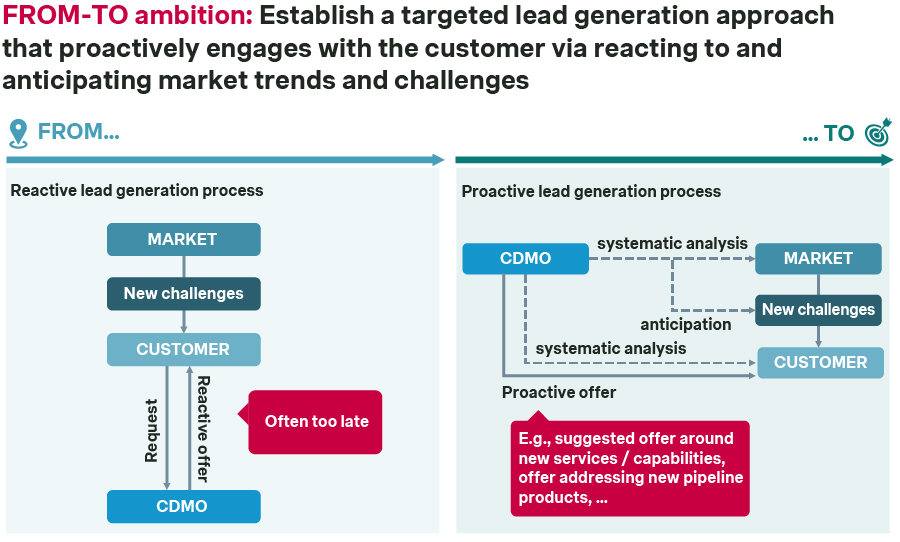
2. Drive omnichannel brand awareness
Why is it important?
• Improved credibility and trust in CDMOs' capabilities, leading to vendor consideration
• Effective activation through targeted engagement with customers across their journey and preferred channels
• Opportunity to expand reach into untapped market segments
• Lower customer acquisition cost vs. resource-intensive and capacity-constrained direct sales activities
CDMOs need to move away from an unstructured and inconsistent marketing approach using independent channels in silos. By using an omnichannel strategy, you can enhance how customers experience your brand and message, driving consistency. This can be done by ensuring a systematic approach to messaging across channels and generating synergies by utilizing a mix of in-person, web-based, and remote customer engagement thereby optimizing budget allocation.
You can utilize different marketing channels, such as trade shows, events, search engine optimization, client testimonials, and social media to significantly boost omnichannel brand experience and widen your reach to new customers. The key to success is deploying repeatable processes with actionable plans to drive structured lead follow-ups supported by data and thorough monitoring of KPIs.
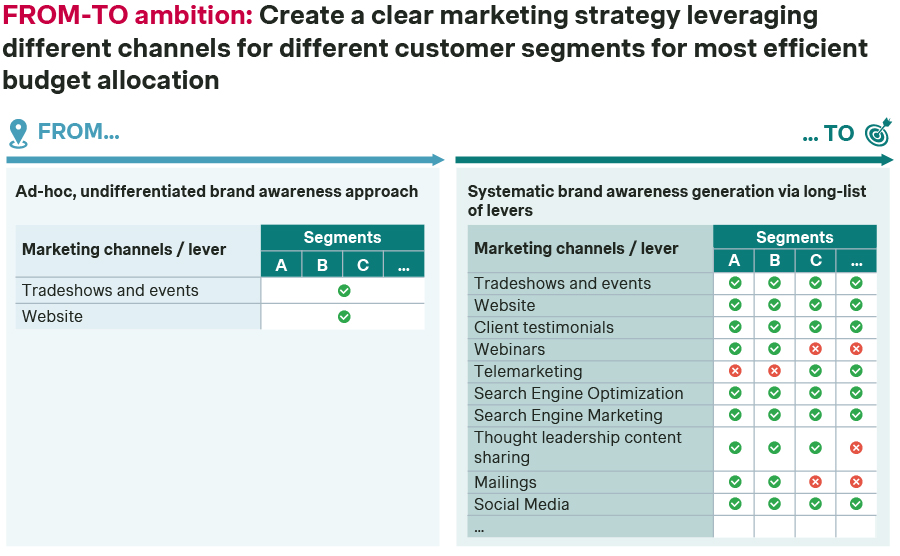
3. Deploy economic benefit-focused value selling
Why is it important?
• Differentiation from other CDMOs to tailored messaging
• Aligned articulation of benefits and internal capabilities
• Higher credibility via quantification of benefits
• Opportunity to discuss "bigger" value themes impacting shareholder value with C-level stakeholders
• Enhanced confidence in negotiations
• Better defense of your price premium against competition
A one-size-fits-all external communication strategy is not as effective as a benefit-focused approach. When CDMOs use feature-based marketing claims like ‘end-to-end services’ or ‘spray drying technology’, the true value of the product or service often gets lost in buzzwords or technical language, alienating the client.
Moving to a value-selling approach requires creating impactful messages that directly address customer pain points. These messages should be specific to each segment and then customized for individual client needs.
You can make the messages more relevant and credible by supporting them with facts and case studies. Additionally, you can translate the value into economic benefits for the client to help motivate potential price premiums.
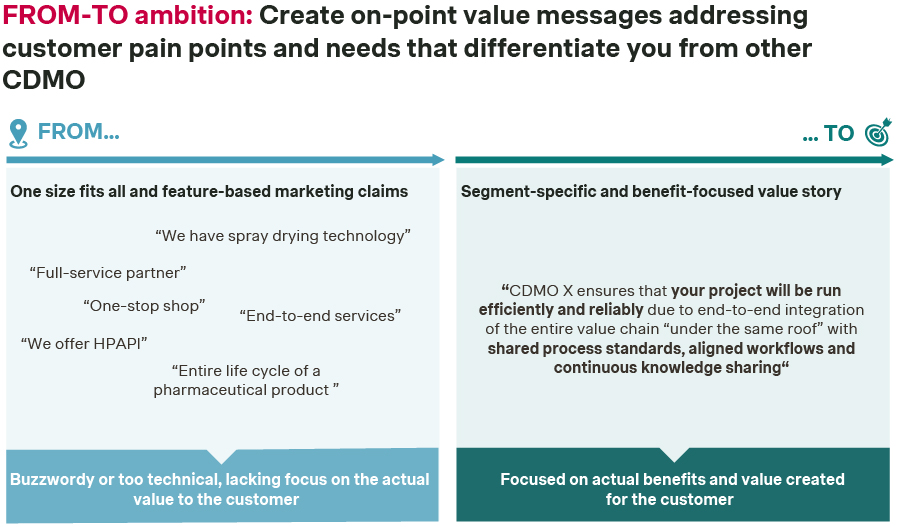
4. Run differentiated opportunity management
Why is it important?
• Fewer lost deals due to lack of engagement speed
• Increased win-rate due to enhanced customer experience
• Better capacity utilization with high-value deals / customers
• Improved resource allocation efficiency
• Aligned internal view on company objectives
Many businesses struggle because they lack a systematic process for assessing potential opportunities, hindering their ability to identify and prioritize valuable prospects. This leads to inefficiencies, missed opportunities, and ineffective resource allocation.
Implementing differentiated opportunity management optimizes resource allocation by systematically evaluating and prioritizing potential leads.
Best-in-class CDMOs prioritize leads based on customer segment, project value, long-term potential, etc., with commercial implications guiding decision-making and resource allocation. We recommend clearly defining these implications for impact. You can also improve customer experience and success rate by focusing on high-priority opportunities with more resources and tailored engagement approaches. Ensure you have a solid information foundation for scoring and gather internal and external data points from various departments to prioritize the right opportunities.
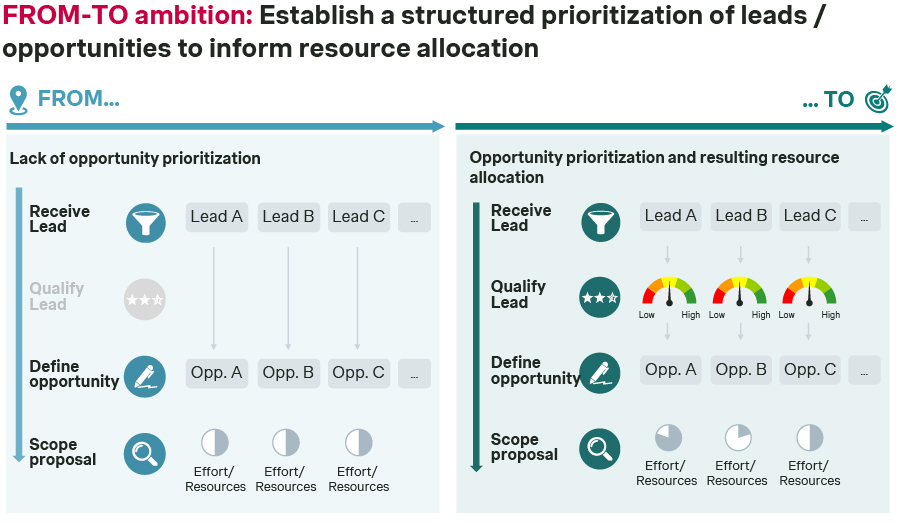
5. Introduce offer modularization
Why is it important?
• Better fit and alignment with customer needs
• Better capture of full customer willingness to pay via clearly defined up- and down-selling pathways
• Enhanced efficiency and turnaround on offers
• Aligned internal view on offer communication and service description
Most CDMOs currently develop offers on a case-by-case basis, lacking structure and organization. We suggest the offer modularization approach, where you structure your offer into distinct parts for a more straightforward and organized configuration process.
Your CDMO marketing and sales strategy improves when the focus is on offering differentiated services based on customer needs and willingness to pay. It requires understanding the preferences of diverse customer groups and strategically building offers that not only fit their budgets but also increase the probability of closing deals.
You can develop budget-friendly offers without compromising quality by removing specific offer elements to lower prices instead of resorting to blanket discounts that chip away at your bottom line. It’s a win-win situation – customers get what they want at a price they love, and you maintain profitability. This means working closely with internal stakeholders to understand the unique value of each service element / level to distinguish essential components from optional ones.
Moreover, you can include good-better-best scope options in proposals to accommodate different budget requirements. Providing additional service package options helps to strategically upsell and stand out from the competition.
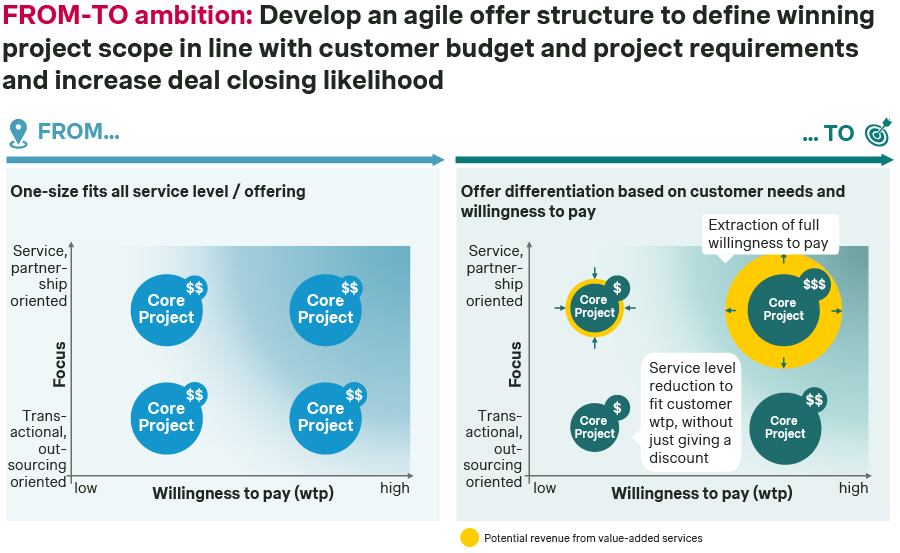
6. Offer win-win revenue models
Why is it important?
• Improved value and willingness to pay extraction
• Increased sales effectiveness via anticipated price model preferences of different customer types
• Captured upside potential in case of positive developments
• Fostered strategic partnership with customers
CDMOs commonly use revenue models with upfront fees, separate from development service and batch charges. These models do not help boost sales effectiveness or nurture strategic customer partnerships.
It’s time to set up win-win revenue models. You can begin by switching from a fixed upfront fee to a no upfront fee model. By removing initial payment and offering discounted fees in exchange for commitment and a higher variable share tied to value delivery, it creates a mutually beneficial scenario.
Make sure that discounts are linked to performance and incentivize clients who continue working with you after successful trial outcomes by granting more discounts. Link the final project fee payout to the level of customer satisfaction with project outcomes.
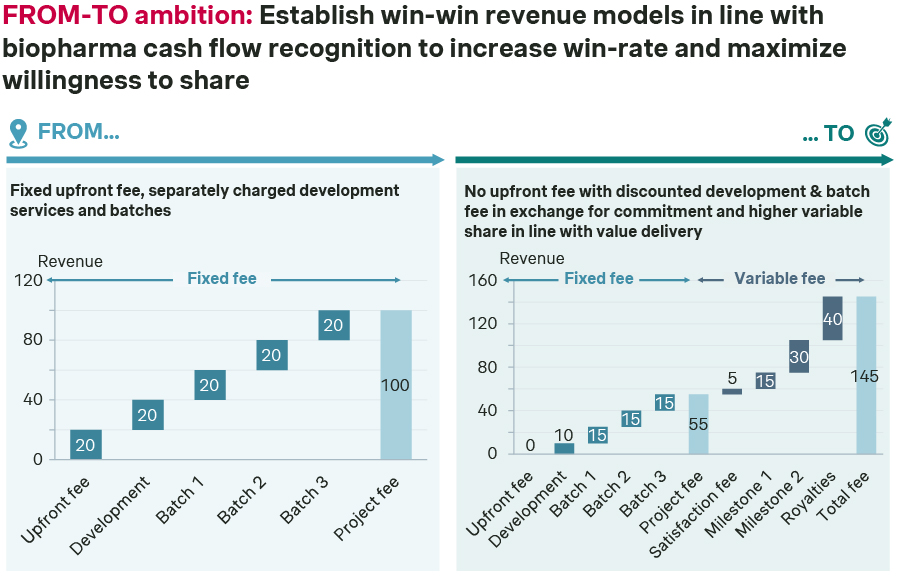
Your CDMO marketing and sales strategy made better
If you’re ready to use these high-impact marketing and sales levers and more – systematic key account management, value-added service offering, calibrated sales incentives, etc. –reach out to us today.
At Simon-Kucher, our consultants and hands-on leadership team specialize in delivering high-quality service across the Healthcare & Life Sciences value chain, specializing in Healthcare B2B and CDMOs.
We will help you define business needs and choose pragmatic solutions to stay competitive and fulfill customer needs quickly.
Ready to elevate your marketing and sales? Contact us to learn more.








